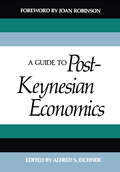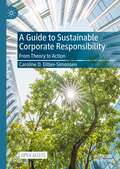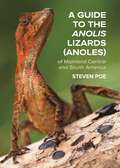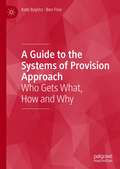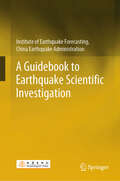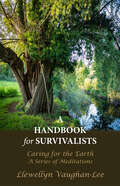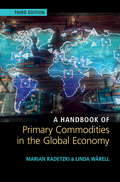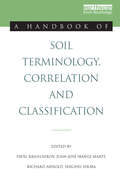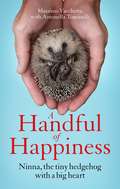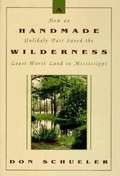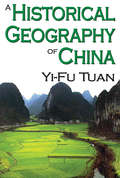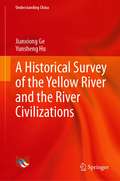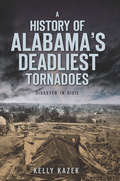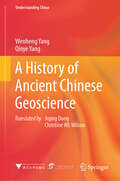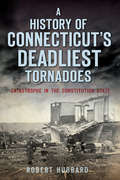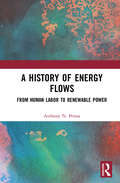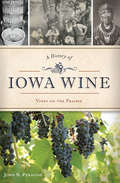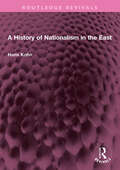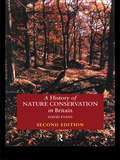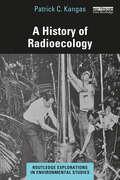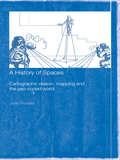- Table View
- List View
A Guide to Post-Keynesian Economics
by Alfred S. EichnerDoes there exist an alternative to the “neoclassical synthesis” presented to students in introductory, intermediate, and advanced economics courses? The alternative is the post-Keynesian theory which is the subject of this book.
A Guide to Scholarly Resources on the Russian Empire and the Soviet Union in the New York Metropolitan Area
by Robert A. KarlowichIdentifies collections held by public and university libraries, historical societies, and other institutions, as well as private collections, with material relating to any subject and historical period, and to the widest geographical area under imperial or Soviet rule. Includes movements for example
A Guide to Spectral Theory: Applications and Exercises (Birkhäuser Advanced Texts Basler Lehrbücher)
by Christophe Cheverry Nicolas RaymondThis textbook provides a graduate-level introduction to the spectral theory of linear operators on Banach and Hilbert spaces, guiding readers through key components of spectral theory and its applications in quantum physics. Based on their extensive teaching experience, the authors present topics in a progressive manner so that each chapter builds on the ones preceding. Researchers and students alike will also appreciate the exploration of more advanced applications and research perspectives presented near the end of the book.Beginning with a brief introduction to the relationship between spectral theory and quantum physics, the authors go on to explore unbounded operators, analyzing closed, adjoint, and self-adjoint operators. Next, the spectrum of a closed operator is defined and the fundamental properties of Fredholm operators are introduced. The authors then develop the Grushin method to execute the spectral analysis of compact operators. The chapters that follow are devoted to examining Hille-Yoshida and Stone theorems, the spectral analysis of self-adjoint operators, and trace-class and Hilbert-Schmidt operators. The final chapter opens the discussion to several selected applications. Throughout this textbook, detailed proofs are given, and the statements are illustrated by a number of well-chosen examples. At the end, an appendix about foundational functional analysis theorems is provided to help the uninitiated reader.A Guide to Spectral Theory: Applications and Exercises is intended for graduate students taking an introductory course in spectral theory or operator theory. A background in linear functional analysis and partial differential equations is assumed; basic knowledge of bounded linear operators is useful but not required. PhD students and researchers will also find this volume to be of interest, particularly the research directions provided in later chapters.
A Guide to Sustainable Corporate Responsibility: From Theory to Action
by Caroline D. Ditlev-SimonsenThis open access book discusses the challenges and opportunities faced by companies in an age that increasingly values sustainability and demands corporate responsibility. Beginning with the historical development of corporate responsibility, this book moves from academic theory to practical application. It points to ways in which companies can successfully manage their transition to a more responsible, sustainable way of doing business, common mistakes to avoid and how the UN Sustainable Development Goals are integral to any sustainability transformation. Practical cases illustrate key points. Drawing on thirty years of sustainability research and extensive corporate experience, the author provides tools such as a Step-by-Step strategic guide on integrating sustainability in collaboration with stakeholders including employees, customers, suppliers and investors. The book is particularly relevant for SMEs and companies operating in emerging markets. From a broader perspective, the value of externalities, full cost pricing, alternative economic theories and circular economy are also addressed.
A Guide to the Anolis Lizards (Anoles) of Mainland Central and South America
by Steven PoeAn authoritative treatment of the diverse and beautiful anole lizards of mainland Central and South AmericaAnoles are highly visible and aesthetically pleasing lizards that are abundant throughout Central and South America. The subjects of countless evolutionary and ecological studies that have advanced our understanding of basic principles in biology, these colorful reptiles are notoriously difficult to identify, and species names are often confusing and inconsistent. A Guide to the Anolis Lizards (Anoles) of Mainland Central and South America is the first book to enable the identification of all known species of anole in the region while establishing baseline knowledge for further research. Drawing on the latest findings, this comprehensive field companion and taxonomic reference is the ultimate guide to these extraordinary lizards.Provides the first stable taxonomy of mainland anoles while aiding field identification of these marvelous neotropical reptilesFeatures hundreds of stunning photos depicting most species, including several species never before photographedDescribes the key identification features and natural history of over 200 species of mainland anolesFacilitates scientific research on evolution, ecology, and species discoveryAn ideal travel companion for ecotourists and other visitors to Central and South AmericaAccompanied by an online identification key
A Guide to the Systems of Provision Approach: Who Gets What, How and Why
by Ben Fine Kate BaylissUnderstanding consumption requires looking at the systems by which goods and services are provided – not just how they are produced but the historically evolved structures, power relations and cultures within which they are located. The Systems of Provision approach provides an interdisciplinary framework for unpacking these complex issues. This book provides a comprehensive account of the Systems of Provision approach, setting out core concepts and theoretical origins alongside numerous case studies. The book combines fresh understandings of everyday consumption using examples from food, housing, and water, with implications for society’s major challenges, including inequality, climate change, and prospects for capitalism. Readers do not require prior knowledge across the subject matter covered but the text remains significant for accomplished researchers and policymakers, especially those interested in the messy real world realities underpinning who gets what, how, and why across public and private provision in global, national, and historical contexts.
A Guidebook to Earthquake Scientific Investigation
by Institute of Earthquake Forecasting, China Earthquake AdministrationThis book concentrates on summarizing previous seismic scientific investigations in order to form standard procedures, approaches, and data sharing for the investigation of future large earthquake. Scientific investigation of large earthquake plays a crucial role in acquiring various records related to earthquake cycle processes and improving the knowledge of earthquake physics and earthquake forecasting. The book aims to provide a guide for the readers seeking earthquake knowledge by probing into the multi-disciplinary investigation of large earthquakes. The book is motivated by recent advances of seismic investigation, including novel geophysical technologies. It is an essential reference to scientifically and systematically investigate future large earthquakes. Chapters are carefully developed to cover seismogenic structure, seismogenic mechanism, earthquake evolution process, influence of the occurred earthquake on regional earthquake hazard, and earthquake disaster mechanism. The book is written for researchers of seismotectonics, earthquake physics, engineering geology, earthquake engineering, natural hazard prevention, and policy-makers engaged in post-hazard restoration.
A Handbook for Survivalists: Caring for the Earth, A Series of Meditations
by Llewellyn Vaughan-LeeWritten while under a wildfire evacuation warning, with bags packed, A Handbook for Survivalists explores the true nature of our survival at this pivotal moment in our shared journey together with the Earth. The present pandemic and its accompanying economic crisis, together with the widespread wildfires and flooding, have shown the fragility of our global systems and a dangerous imbalance with the natural world. Lengthening food lines and burned buildings, smoke-filled skies, have given us a foretaste of a future of climate crisis and radical uncertainty. What are the real values we need at this time when confronted by the divisiveness of our present culture in which the poor suffer most, and how can we transition into a future which respects the more-than-human world to which we belong?Looking deeper than merely physical survival, Llewellyn Vaughan-Lee explores the roots of this present imbalance in our separation from the Earth, and a vital need to reconnect, to regain the knowing of our ancestors who walked on sacred land. Returning to a deep awareness of our interconnected oneness with the living Earth, this book gives us the foundation for a new story for humanity, one not based upon exploitation and greed. A Handbook for Survivalists offers us tools to help in this transition, both in the resilience needed to survive the coming environmental and social breakdown, and in the ways to give birth to a living future. It explores subjects such as destiny, living with chaos, and the central theme of death and rebirth—how to seed a sustainable future for both humanity and the Earth.A Handbook for Survivalists is full of encouragement of how we can transition into this future without glossing over the catastrophes and hardships that we are already encountering. Combining an understanding of the potential for a real shift in consciousness with an awareness of the global forces resisting any such change, Llewellyn Vaughan-Lee takes us on a journey back to when our spiritual nature was bonded with the Earth and its magical nature. This is spiritual empowerment in its deepest sense because it transforms not just the individual but our relationship with the Earth and its diverse community to which we belong.A core element of this empowerment comes from understanding our spiritual nature in relationship to the Earth. Indigenous Peoples live this awareness through prayers, ceremonies, and other practices. We have mostly forgotten this dimension of our spiritual nature, but in our soul and within the world around us is a divine light that is needed to help us heal and nurture the web of life we are destroying. Learning to work with this light—which belongs to mystical and shamanic traditions—we can continue the practice of our ancestors and help to keep the world in balance.Finally this book offers a love story for the Earth. We can help the world remember what our culture has forgotten—how the soil, the seeds, the rivers and the stars all carry a central message of love. In all its diverse forms, its different ways of being and breathing, the living Earth is a celebration of love. And now it is calling out to us, crying to us to remember its sacred nature.
A Handbook of Primary Commodities in the Global Economy
by Marian Radetzki Linda WårellThe dramatic price falls of 2014–2015 marked the end of the most powerful and enduring commodity boom since the Second World War. Now in its third edition, this book acts as a guide to the ins and outs of the primary commodity universe. Updates to this edition reflect on the consequences of both China's economic slowdown as its industrialization enters a new, less commodity demanding phase, and changes in the USA's trade policy under the Trump administration. Additionally, this edition takes into account recent developments in world oil markets and examines the effects of increased climate concerns. The authors introduce and explain pertinent issues surrounding international commodity markets such as the global geography of raw materials, price formation, price trends, the role of commodity exchanges, the threat of depletion, cartel action, state ownership, emerging commodity nationalism and more.
A Handbook of Soil Terminology, Correlation and Classification
by Richard Arnold Serghei ShobaSoil classification and terminology are fundamental issues for the clear understanding and communication of the subject. However, while there are many national soil classification systems, these do not directly correlate with each other. This leads to confusion and great difficulty in undertaking comparative scientific research that draws on more than one system and in making sense of international scientific papers using a system that is unfamiliar to the reader. This book aims to clarify this position by describing and comparing different systems and evaluating them in the context of the World Reference Base (WRB) for Soil Resources. The latter was set up to resolve these problems by creating an international 'umbrella' system for soil correlation. All soil scientists should then classify soils using the WRB as well as their national systems. The book is a definitive and essential reference work for all students studying soils as part of life, earth or environmental sciences, as well as professional soil scientists. Published with International Union of Soil Sciences
A Handbook of Sustainable Building Design and Engineering: An Integrated Approach to Energy, Health and Operational Performance (Best (buildings Energy And Solar Technology) Ser.)
by Dejan Mumovic and Mat SantamourisThe second edition of this authoritative textbook equips students with the tools they will need to tackle the challenges of sustainable building design and engineering. The book looks at how to design, engineer and monitor energy efficient buildings, how to adapt buildings to climate change, and how to make buildings healthy, comfortable and secure. New material for this edition includes sections on environmental masterplanning, renewable technologies, retrofitting, passive house design, thermal comfort and indoor air quality. With chapters and case studies from a range of international, interdisciplinary authors, the book is essential reading for students and professionals in building engineering, environmental design, construction and architecture.
A Handful of Happiness: Ninna, the tiny hedgehog with a big heart
by Massimo VacchettaThe heart-warming story of how a tiny hedgehog helped one man find hope. 'Could you look after it for a couple of days? . . .' So begins the extraordinary friendship between veterinarian Massimo, who is at a low spot in his life, and a tiny, orphaned hedgehog. Only a few days old, covered with soft, white quills and mewling quietly, this little creature will turn around his life forever. Through the sheer force of Ninna's personality - curious, playful, affectionate - and the sudden, unexpected paternal protectiveness he feels nursing her back to health, Massimo reconnects with the world - and finally begins to feel like home. But as Ninna wakes from her first hibernation, she grows up, like any teenager, longing for freedom. A creature of the wild, she craves the free range of the woods beyond Massimo's house. Massimo must accept that Ninna is ready to move on . . . but one little hedgehog saved and released into her natural habitat is a new beginning for Massimo: setting up a sanctuary for the injured, orphaned, fragile - but with a will to live so strong it is truly contagious.A Handful of Happiness is their funny and life-affirming story - a celebration of our favourite prickly wildlife creature, which will make you laugh and cry. Perfect for animal lovers and fans of A Streetcat Named Bob, Arthur, Finding Gobi and Monty Don's Nigel.
A Handmade Wilderness
by Don SchuelerAs this book vividly narrates, in 1968, when Don Schueler and Willie Brown bought eighty acres in Mississippi, all they could afford was a piece of "least worst land." Moonshiners and poachers tried to scare them off, but Don and Willie stuck it out, restoring "The Place," bringing back the wildlife and plant life, until they had created a handmade wilderness containing every ecosystem found in the region.
A Historical Geography of China
by Yi-Fu TuanThe Chinese earth is pervasively humanized through long occupation. Signs of man's presence vary from the obvious to the extremely subtle. The building of roads, bridges, dams, and factories, and the consolidation of farm holdings alter the Chinese landscape and these alterations seem all the more conspicuous because they introduce features that are not distinctively Chinese. In contrast, traditional forms and architectural relics escape our attention because they are so identified with the Chinese scene that they appear to be almost outgrowths of nature. Describing the natural order of human beings in the context of the Chinese earth and civilization, "A Historical Geography of China" narrates the evolution of the Chinese landscape from prehistoric times to the present.Tuan views landscape as a visible expression of man's efforts to gain a living and achieve a measure of stability in the constant flux of nature. The book ranges the period of time from Peking man to the epoch of Mao Tse-tung. It moves through the ancient and modern dynasties, the warlords and conquests, earthquakes, devastating floods, climatic reversals, and staggering civil wars to the impact of Western civilization and industrialization. The emphasis throughout is on the effect of a changing environment on succeeding cultures.This classic study attempts to analyze and describe traditional Chinese settlement patterns and architecture. The result is a clear and succinct examination of the development of the Chinese landscape over thousands of years. It describes the ways the Communist regime worked to alter the face of the nation. This work will quickly prove to be crucial reading for all who are interested in this pivotal nation. It goes far beyond the usual political spectrum, into the physical and social roots of Chinese history.
A Historical Survey of the Yellow River and the River Civilizations (Understanding China)
by Jianxiong Ge Yunsheng HuThis book explores the relationship between rivers and ethics in China, with a particular focus on the health of the Yellow River and China’s sustainable development. Though the book falls into the category of East Asian History, it is an interdisciplinary academic work that addresses not only history, but also culture, human geography and physical geography.It traces the changes in the Yellow River over time and examines the origin and developmental course of Chinese civilization, which has always been closely intertwined with the Yellow River. It also draws comparisons between the Yellow River and the Yangtze, Nile, Tigris, Euphrates and Indus rivers to provide insights into how they have contributed to civilizations. At the same time, it discusses the lessons learned from people’s taming the Yellow River.Most significantly, the book explores the relationship between humans and the environment from an ethical standpoint, making it an urgent reminder of the crucial role that human activities play in environmental issues concerning the Yellow River so as to achieve a sustainable development for China’s “mother river.” The intended audience includes academic readers researching East Asian and Chinese history & culture, geography, human geography, historical geography, the environment, river civilizations, etc., as well as history and geography lovers and members of the general public who are interested in the Yellow River and the civilization that has evolved around it.
A History of Alabama's Deadliest Tornadoes: Disaster in Dixie
by Kelly KazekJourney just west of America's infamous Tornado Alley to Alabama, home to some of the deadliest tornadoes of the past century. These twisters remain etched in the collective memory of the people, from the 1908 Dixie Tornado, regarded as one of the most brutal tornadoes in U.S. history, to the 1998 Birmingham Tornado, the most expensive twister in Alabama's history. Discover how the 1932 Deep South Tornadoes resulted in 268 fatalities and millions of dollars in damage, and read the terrifying account of the 1977 Smithfield Tornadoes, which rocked this Birmingham suburb with as many as six twisters in a one-hour span. Join local journalist Kelly Kazek as she shares the tales of these natural disasters and the hardy Alabamians who endured them.
A History of Ancient Chinese Geoscience (Understanding China)
by Wenheng Yang Qinye YangThis book studies the history of geoscience in ancient China. Building on a comprehensive review of the historical development of Chinese geoscience, the authors map out the trends and patterns in the development of geoscience, thereby filling a research gap in this field and laying the groundwork for a systematic study of the history of Chinese geoscience. The Chinese version of this book was selected as a key national book planning project under China’s 12th Five-Year Plan and was funded by the National Publication Foundation. It also won the 6th China Outstanding Publication Award. Encompassing historical accounts of both geography and geology, the book explores the origin, development and prosperity of ancient Chinese geoscience. It introduces a wide range of topics covering a time span from the primitive societies to the Late Qing dynasty. In each time period, as well as discussion of the contexts, topics include the mainstream schools of thought, scientific discoveries and their significance, scholarly works, well-known experts, major research activities, research institutes, educational programmes, academic journals, scientific instruments, and knowledge exchange. The book also deals with the history of several neighbouring disciplines such as climatology, cartology, hydrology, geomorphology and mineral petrology. The authors provide an exceptionally detailed description of geoscience in embryo – the forming of early knowledge of the Earth in primitive society. For the first time, philosophers’ geoscientific understanding of the world and the findings of historical mineralogy and petrology are brought to the fore, supported by data from various sources including ancient literature, archives and documentation, archaeological sites, cultural artefacts and modern experimental evidence. The novel design of contextualising each phase of development in its unique social-political conditions is unprecedented and of high academic and social value. Marked by its specialised interpretation and scientific rigour, this work proves to be unparalleled in revealing the reciprocity between scientific innovation and societal transformation, thus providing valuable lessons and inspiration for future geoscientists. As a reference book on the history of geoscience, it aims to provide specialist guidance for professionals in the field of geoscience, geoscience historians and researchers, university teachers and students in relevant disciplines, and teachers of geography or science in primary or secondary schools.
A History of Canada in Ten Maps: Epic Stories of Charting a Mysterious Land
by Adam ShoaltsThe sweeping, epic story of the mysterious land that came to be called “Canada” like it’s never been told before. Every map tells a story. And every map has a purpose--it invites us to go somewhere we've never been. It’s an account of what we know, but also a trace of what we long for. Ten Maps conjures the world as it appeared to those who were called upon to map it. What would the new world look like to wandering Vikings, who thought they had drifted into a land of mythical creatures, or Samuel de Champlain, who had no idea of the vastness of the landmass just beyond the treeline? Adam Shoalts, one of Canada’s foremost explorers, tells the stories behind these centuries old maps, and how they came to shape what became “Canada.” It’s a story that will surprise readers, and reveal the Canada we never knew was hidden. It brings to life the characters and the bloody disputes that forged our history, by showing us what the world looked like before it entered the history books. Combining storytelling, cartography, geography, archaeology and of course history, this book shows us Canada in a way we've never seen it before.
A History of Connecticut's Deadliest Tornadoes: Catastrophe in the Constitution State (Disaster)
by Robert HubbardThe Wallingford tornado of 1878 took less than two minutes, but it killed at the rate of one person per second. Twisters in Connecticut are incredibly rare, but they're often disastrous and sometimes deadly. The Windsor tornado of 1979 destroyed a field of aircraft that had survived World War II. The 1787 Wethersfield tornado ripped off a barn roof in New Britain, traveled on to Newington and finally subsided in Wethersfield after destroying a family farm. Locals remember the 1989 cyclone that ripped through Hamden and cost the state millions of dollars in repairs. Join local author Robert Hubbard as he shares the tales of these natural disasters and those who witnessed them.
A History of Energy Flows: From Human Labor to Renewable Power
by Anthony N. PennaThis book presents a global and historical perspective of energy flows during the last millennium. The search for sustainable energy is a key issue dominating today’s energy regime. This book details the historical evolution of energy, following the overlapping and slow flowing transitions from one regime to another. In doing so it seeks to provide insight into future energy transitions and the means of utilizing sustainable energy sources to reduce humanity’s fossil fuel footprint. The book begins with an examination of the earliest and most basic forms of energy use, namely, that of humans metabolizing food in order to work, with the first transition following the domestication and breeding of horses and other animals. The book also examines energy sources key to development during the industrialization and mechanization, such as wood and coal, as well as more recent sources, such as crude oil and nuclear energy. The book then assesses energy flows that are at the forefront of sustainability, by examining green sources, such as solar, wind power and hydropower. While it is easy to see energy flows in terms of “revolutions,” transitions have taken centuries to evolve, and transitions are never fully global, as, for example, wood remains the primary fuel source for cooking in much of the developing world. This book not only demonstrates the longevity of energy transitions but also discusses the possibility for reducing transition times when technological developments provide inexpensive and safe energy sources that can reduce the dependency on fossil fuels. This book will be of great interest to students and scholars of energy transitions, sustainable energy and environmental and energy history.
A History of Iowa Wine: Vines on the Prairie (American Palate)
by John N. PeragineIowa has a history with grapevines that goes back more than a century. New York lawyer Hiram Barney obtained a tract of land in southeast Iowa as part of the Half-Breed program following the American Indian Wars and created the White Elk Winery. German settlers in Amana tended community vineyards for communal wines. Before Prohibition, the Council Bluffs Grape Growers Association grew grapes and shipped them eastward by the ton. In the early 1900s, the state was among the nation's top producers of grapes. Pesticides, weather and government subsidies ended the time of the vines of the prairie until their recent return. Author John N. Peragine details the rise, fall and resurgence of the industry in the Hawkeye State.
A History of Nationalism in the East (Routledge Revivals)
by Hans KohnFirst published in 1929, A History of Nationalism in the East brings together in one truly fascinating volume a mass of information hitherto scattered and partly unavailable. Hans Kohn sums up the general situation in his Introduction. He tells us that the World War I produced three great communities of interest, distinct and, to some extent, mutually antagonistic. The first was that of the continent of Europe, barring Russia, which was faced with the necessity for the gradual breaking down of national boundaries, for political, financial, and economic reasons. The second was that of the Anglo-Saxon people, the United States, Great Britain, Canada, Australia, and South Africa. This had to face Soviet Russia on the one hand, and the Oriental, the third, community of interests on the other. Here he sketches suggestively the development of the nationalist movement in Islam, India, Egypt, Turkey, Arabia, and Persia. The language used is a reflection of its era and no offence is meant by the Publishers to any reader by this republication. This book will be of interest to students of history, political science, international relations, and geography.
A History of Nature Conservation in Britain
by David EvansOur attitudes towards `nature' and the countryside are fickle. The conservation movement, despite enjoying its highest membership ever, has achieved only limited success over the last one hundred years of campaigning. Can conservationists now shake off their insular, disunited and negative image so as to gain the influence that the size of their movement warrants? A History of Nature Conservation in Britain traces the rise of the conservation movement from its beginnings in Victorian coffee houses to today's societies with their membership numbering in the millions. The first complete history of the British, and oldest, branch of the movement, David Evans's book offers invaluable insights into the campaigns for countryside protection and access, from battles against the use of pesticides, against pollution and genetic engineering through to legislation for the protection of our wildlife and the freedom to walk the mountains. The 2nd Edition has been fully revised and updated. Topical issues are considered afresh; and new chapters reflect the rapid changes throughout the 1990s both in social attitudes, conservation practices, legislation, funding and within conservation organizations themselves. In the light of recent developments, Evans also looks at some difficult choices to be made in years ahead and asks how the conservation movement will fare on the new global stage.
A History of Radioecology (Routledge Explorations in Environmental Studies)
by Patrick C. KangasThis book presents a history of radioecology, from World War II through to the critical years of the Cold War, finishing with a discussion of recent developments and future implications for the field. Drawing on a vast array of primary sources, the book reviews, synthesizes and discusses the implications of the ecological research supported by the Atomic Energy Commission (AEC) of the United States government, from World War II to the early 1970s. This was a critical period in the history of ecology, characterized by a transition from the older, largely descriptive studies of communities of plants and animals to the modern form of the science involving functional studies of energy flow and mineral cycling in ecosystems. This transition was in large part due to the development of radioecology, which was a by-product of the Cold War and the need to understand and predict the consequences of a nuclear war that was planned but has never occurred. The book draws on important case studies, such as the Pacific Proving Grounds, the Nevada Test Site, El Verde in Puerto Rico, the Brookhaven National Laboratory and recent events such as the nuclear disasters at Chernobyl and Fukushima. By revisiting studies and archived information from the Cold War era, this book offers lessons from the history of radioecology to provide background and perspective for understanding possible present-day impacts from issues of radiation risks associated with nuclear power generation and waste disposal. Post-Cold War developments in radioecology will be also reviewed and contrasted with the AEC-supported ecology research for further perspectives. This book will be of great interest to students and scholars of radioecology, environmental pollution, environmental technology, bioscience and environmental history.
A History of Spaces: Cartographic Reason, Mapping and the Geo-Coded World
by John PicklesThis book provides an essential insight into the practices and ideas of maps and map-making. It draws on a wide range of social theorists, and theorists of maps and cartography, to show how maps and map-making have shaped the spaces in which we live.Going beyond the focus of traditional cartography, the book draws on examples of the use of maps from the sixteenth century to the present, including their role in projects of the national and colonial state, emergent capitalism and the planetary consciousness of the natural sciences. It also considers the use of maps for military purposes, maps that have coded modern conceptions of health, disease and social character, and maps of the transparent human body and the transparent earth.
